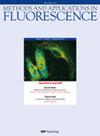Portable ratiometric fluorescence detection of Cu2+ and thiram
IF 2.4
3区 化学
Q3 CHEMISTRY, ANALYTICAL
引用次数: 0
Abstract
Food contaminants pose a danger to human health, but rapid, sensitive and reliable food safety detection methods can offer a solution to this problem. In this study, an optical fiber ratiometric fluorescence sensing system based on carbon dots (CDs) and o-phenylenediamine (OPD) was constructed. The ratiometric fluorescence response of Cu2+ and thiram was carried out by the fluorescence resonance energy transfer (FRET) between CDs and 2,3−diaminophenazine (ox-OPD, oxidized state o-phenylenediamine). The oxidation of OPD by Cu2+ resulted in the formation of ox-OPD, which quenched the fluorescence of CDs and exhibited a new emission peak at 573 nm. The formation of a [dithiocarbamate-Cu2+] (DTC-Cu2+) complex by reacting thiram with Cu2+, inhibits the OPD oxidation reaction triggered by Cu2+, thus turning off the fluorescence signal of OPD-Cu2+. The as-established detection system presented excellent sensitivity and selectivity for the detection of Cu2+ and thiram in the ranges of 1 ∼ 100便携式比率荧光检测 Cu2+ 和福美双
食品污染物对人类健康造成危害,而快速、灵敏、可靠的食品安全检测方法可以解决这一问题。本研究构建了一种基于碳点(CD)和邻苯二胺(OPD)的光纤比率荧光传感系统。通过 CD 与 2,3-二氨基吩嗪(ox-OPD,氧化态邻苯二胺)之间的荧光共振能量转移(FRET),实现了 Cu2+ 与噻喃的比率荧光响应。OPD 被 Cu2+ 氧化后形成 ox-OPD,它淬灭了 CD 的荧光,并在 573 纳米处显示出新的发射峰。噻喃与 Cu2+ 反应形成的[二硫代氨基甲酸-Cu2+](DTC-Cu2+)复合物抑制了 Cu2+ 触发的 OPD 氧化反应,从而关闭了 OPD-Cu2+ 的荧光信号。所建立的检测系统在 1 ∼ 100 μM 和 5 ∼ 50 μM 的范围内对 Cu2+ 和噻喃的检测具有良好的灵敏度和选择性。Cu2+ 和噻喃的最低检测限分别为 0.392 μM 和 0.522 μM。此外,实际样品分析表明,该传感器具有在实际样品分析中进行 Cu2+和噻喃检测的潜力。
本文章由计算机程序翻译,如有差异,请以英文原文为准。
求助全文
约1分钟内获得全文
求助全文
来源期刊

Methods and Applications in Fluorescence
CHEMISTRY, ANALYTICALCHEMISTRY, PHYSICAL&n-CHEMISTRY, PHYSICAL
CiteScore
6.20
自引率
3.10%
发文量
60
期刊介绍:
Methods and Applications in Fluorescence focuses on new developments in fluorescence spectroscopy, imaging, microscopy, fluorescent probes, labels and (nano)materials. It will feature both methods and advanced (bio)applications and accepts original research articles, reviews and technical notes.
 求助内容:
求助内容: 应助结果提醒方式:
应助结果提醒方式:


